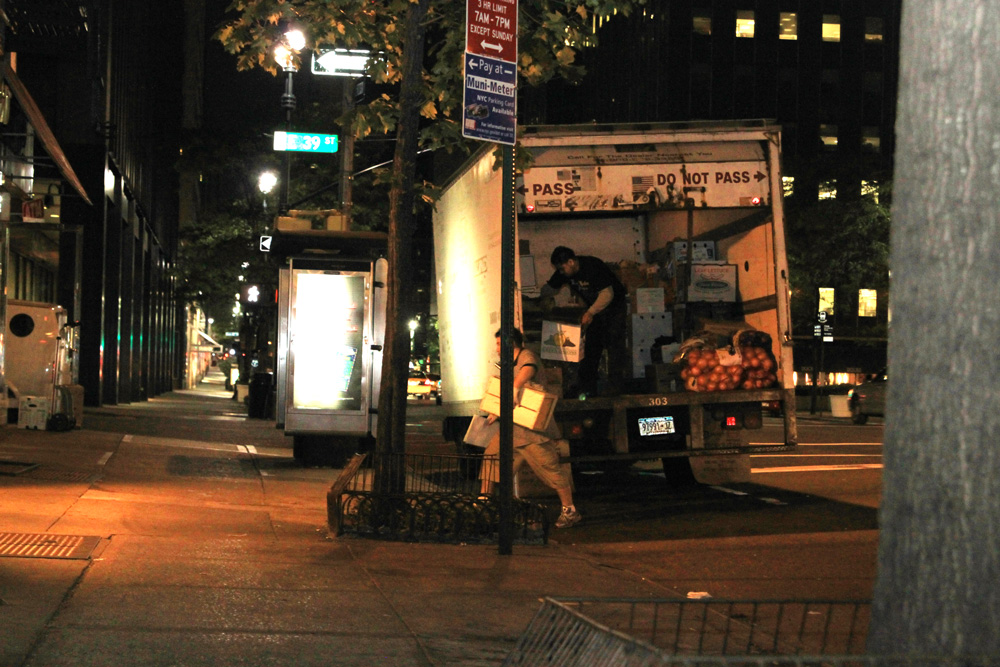
Photo: NYC_Truck_Delivery2
New York to introduce new system for freight
23 May 2017
by Jonathan Andrews
Nick Michell spoke with Michael Replogle, Deputy Commissioner for Policy, New York City Department of Transportation, on the city’s plans to improve its freight system
How important is it for New York to improve the efficiency and effectiveness of its freight system? What are the main obstacles?
To remain a great global centre, it’s vital for New York to improve its freight systems. The big players in the private logistics industry are innovating for efficiency, but it’s harder for small truckers to do so. Obstacles arise from archaic laws that are hard to change, struggles between competing authorities, and fragmented governance. But as a city, we are making progress using data, technology, and partnerships to support smarter traffic management.
Demand for the city’s streets has grown dramatically and that impairs freight efficiency. Between 2010 and 2015, the city added 370,000 new residents and 520,000 jobs. Since 2000, tourism has surged 61 percent to 58 million visitors. Construction is booming, with a record 56,000 new housing units approved in 2015. Almost 11 million square feet [1 million square metres] of office space has been added in Manhattan since 2010.
New York City is handling related travel demand growth by leveraging existing subway capacity and increasing walking and biking. As a result, there were 45,000 fewer vehicles per day entering Manhattan south of 60th Street in 2015 than in 2010, down 6 percent. In the same period, daily subway ridership grew 22 percent to 5.7 million, the number of frequent bike riders rose 54 percent to 778,000, and pedestrian activity increased 10 percent. Overall, 87 percent of trips destined for Manhattan are by public transport, walking or biking, while only 13 percent are by private car or taxi.
Expanded bus, bike and pedestrian facilities have mostly been put in place without reducing overall lane capacity. But competition for curb and street space remains epic. As the city attracts more visitors, workers, and residents, sidewalks and crosswalks are regularly overflowing with pedestrians. With more construction has come an increase in lane closures which can slow traffic. There is growing evidence that the transition from taxis to app-based ride-hailing services may be increasing the number of vehicles in circulation especially in Midtown Manhattan.
All of this puts pressure on the efficiency of freight mobility, which depends almost entirely on trucks. Freight trips are rising steadily as on-line shopping grows. The number of deliveries to residences is up 30 percent in just five years. Trucks frequently double park because curbside loading zones are filled by municipal and service vehicles, cars used by those with disabilities, and illegal parkers. Double parking further reduces street throughput capacity, causing congestion.

Is it difficult to persuade companies to move to off-hour deliveries, considering the extra staffing costs that may be involved?
Many businesses want just-in-time shipping and dictate the time for deliveries. The higher costs of daytime deliveries and parking fines get absorbed into the cost of doing business. Indeed, in New York only 1 out of 20 deliveries now take place off hours–after 7pm or before 6am. For some businesses, shifting to assisted night time deliveries would require extra staff, but many food retailers already accept off-hour deliveries without extra staffing.
A third of commercial establishments in New York report having a vendor they would trust to make unattended off-hour deliveries (OHD). Various practices can also cut the risk or costs of unassisted off-hour deliveries, such as key locks, use of electronic doormen, delivery lockers, and virtual delivery cages defined by laser beams. Twenty percent or more of truck traffic in Manhattan could potentially shift to OHD with a modest shift in expectations and practices.
Between 2009 and 2013, New York City’s OHD programme, a public-private-academic partnership, provided a one-time cash incentive of between US$1,000 to US$2,000 to 400 commercial establishments that agreed to adopt off-hour deliveries. These represent 2 percent of retail and food sector establishments in Manhattan. Nearly all have continued off-hour deliveries. Of the receiver businesses in New York’s OHD pilot, 88 percent report that their impression of the OHD programme was very favourable or favourable. Truck drivers and delivery company managers are also highly favourable to the programme, which has reduced their costs and increased their efficiency.
There are barriers to OHD, such as building leases that prohibit nighttime deliveries, labour and building rules governing freight elevator operations, and neighbourhood concerns about nighttime noise. But these can often be addressed with low-noise equipment and monitoring, development of building delivery plans, and expanded partnerships with stakeholders.
To help cut congestion and pollution, the city is now expanding its OHD programme, with a goal of recruiting 900 establishments over the next two years.
How much emphasis is being put on developing data-driven freight routes and regulations?
A key theme of New York City Department of Transportation’s Strategic Plan 2016 is using data and technology to better support smart curb and street management. We’re developing a new citywide freight plan to update freight routes and regulations, supported by new data. In parallel, we are completing a survey of commercial parking areas across the city to guide a new Parking Blueprint. We’re exploring new ways to use stationary and mobile cameras, sensors, and image analytics to measure curb occupancy, double parking, and loading dock activity, as well as detect off-route or overweight trucks, traffic speeds, and traffic safety problems. This will support planning and operations, that gives us information on where to reallocate curb regulations. It will also enable new ways to target real-time enforcement by traffic police agents.

How do you improve efficiency while also reducing the environmental footprint and enhancing liveability?
Improved efficiency is essential to enable better mobility by people and freight while improving liveability and environmental quality. No single strategy can do this. We need smarter planning and logistics to avoid unnecessary and costly travel. We need to shift travel to more efficient modes where practical, expanding options for multi-modal maritime and rail freight linked to efficient last-mile distribution systems. We need more efficient management of scarce street and curb space through telematics, regulation, and incentives. And we need technologies that improve the efficiency of the remaining travel by encouraging cleaner vehicles and fuels, electrification of transport, and a longer-term shift to autonomous mobility. Increasing automation of freight and passenger transport in coming decades could provide large benefits to urban liveability, equity, and the environment, depending on how this process is managed.
Should cities be working more closely to share progress and information, and how could urban mobility indicators aid this? Is this something New York is working on?
In nearly four decades of professional life, I’ve found that the best way to identify solutions to really hard problems in urban transport is to learn how various cities across the world have worked to address them. There’s so much we can gain by adapting best practices from each other and exploring why strategies have done better in some places than in others.
As we developed our latest NYC DOT Strategic Plan and our related greenhouse gas action strategy, we reviewed a number of urban mobility indicators. It’s clear New York City is ahead of peer cities in our hemisphere in reducing car use and per capita carbon dioxide emissions, but we lag some of our global peer cities in Europe and Asia. We are working to learn from global best practices and welcome opportunities to increase exchange of information.








